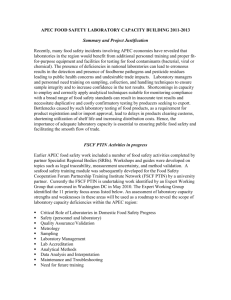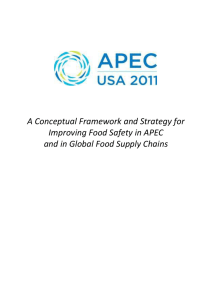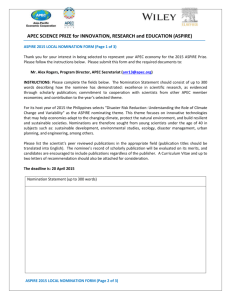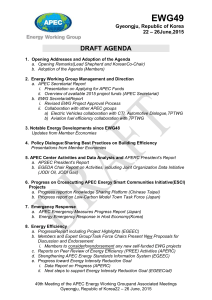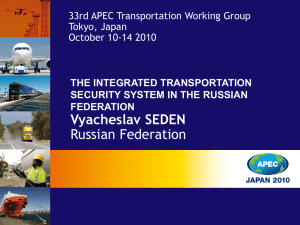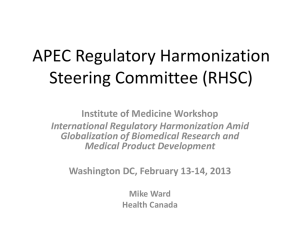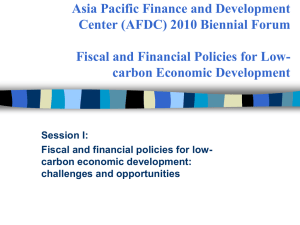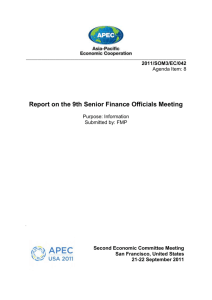word - Food Standards Australia New Zealand
advertisement
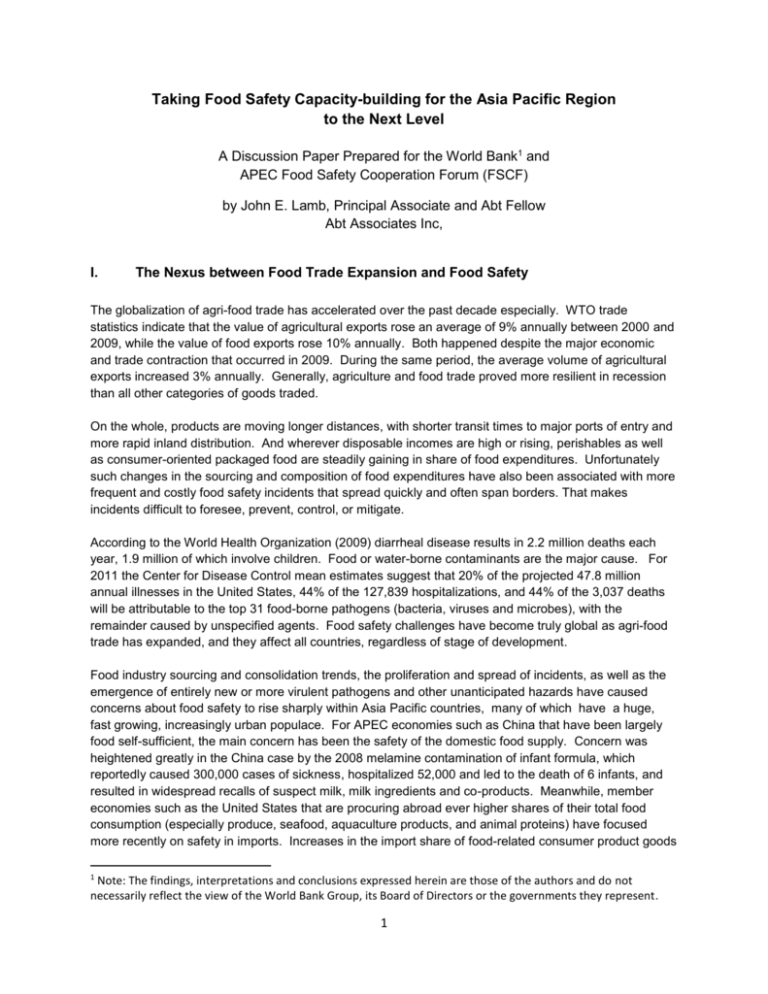
Taking Food Safety Capacity-building for the Asia Pacific Region to the Next Level A Discussion Paper Prepared for the World Bank1 and APEC Food Safety Cooperation Forum (FSCF) by John E. Lamb, Principal Associate and Abt Fellow Abt Associates Inc, I. The Nexus between Food Trade Expansion and Food Safety The globalization of agri-food trade has accelerated over the past decade especially. WTO trade statistics indicate that the value of agricultural exports rose an average of 9% annually between 2000 and 2009, while the value of food exports rose 10% annually. Both happened despite the major economic and trade contraction that occurred in 2009. During the same period, the average volume of agricultural exports increased 3% annually. Generally, agriculture and food trade proved more resilient in recession than all other categories of goods traded. On the whole, products are moving longer distances, with shorter transit times to major ports of entry and more rapid inland distribution. And wherever disposable incomes are high or rising, perishables as well as consumer-oriented packaged food are steadily gaining in share of food expenditures. Unfortunately such changes in the sourcing and composition of food expenditures have also been associated with more frequent and costly food safety incidents that spread quickly and often span borders. That makes incidents difficult to foresee, prevent, control, or mitigate. According to the World Health Organization (2009) diarrheal disease results in 2.2 million deaths each year, 1.9 million of which involve children. Food or water-borne contaminants are the major cause. For 2011 the Center for Disease Control mean estimates suggest that 20% of the projected 47.8 million annual illnesses in the United States, 44% of the 127,839 hospitalizations, and 44% of the 3,037 deaths will be attributable to the top 31 food-borne pathogens (bacteria, viruses and microbes), with the remainder caused by unspecified agents. Food safety challenges have become truly global as agri-food trade has expanded, and they affect all countries, regardless of stage of development. Food industry sourcing and consolidation trends, the proliferation and spread of incidents, as well as the emergence of entirely new or more virulent pathogens and other unanticipated hazards have caused concerns about food safety to rise sharply within Asia Pacific countries, many of which have a huge, fast growing, increasingly urban populace. For APEC economies such as China that have been largely food self-sufficient, the main concern has been the safety of the domestic food supply. Concern was heightened greatly in the China case by the 2008 melamine contamination of infant formula, which reportedly caused 300,000 cases of sickness, hospitalized 52,000 and led to the death of 6 infants, and resulted in widespread recalls of suspect milk, milk ingredients and co-products. Meanwhile, member economies such as the United States that are procuring abroad ever higher shares of their total food consumption (especially produce, seafood, aquaculture products, and animal proteins) have focused more recently on safety in imports. Increases in the import share of food-related consumer product goods 1 Note: The findings, interpretations and conclusions expressed herein are those of the authors and do not necessarily reflect the view of the World Bank Group, its Board of Directors or the governments they represent. 1 have also been occurring in many Latin American economies, including APEC economies located there, yet the concern in that region has been less about the safety of imports and more about the potential impact of food safety incidents on agri-food exports of economic importance. II. Origins of the APEC Food Safety Cooperation Forum The APEC Food Safety Cooperation Forum (FSCF) was first established several years ago through a formative meeting held in Australia that resulted in the signing of the “Hunter Valley 2007 Statement,” which envisioned partners working together both to improve public health and facilitate trade, by building robust food safety systems amongst APEC member economies. The FSCF’s main goal was to assist APEC Member Economies to achieve: 1. Transparent information-sharing and communications networks that provide accurate and timely information to consumers and producers on food safety. 2. Food safety regulatory systems within economies, including food inspection/assurance and certifications systems that are: (a) consistent with members’ rights and obligations under the SPS and TBT Agreements of the WTO; and (b) harmonized to the extent possible with international standards such as Codex, OIE, and IPPC. 3. Enhanced technical skills and human resource capacities to enable the development of national food safety regulatory frameworks that are harmonized with international standards. Since APEC is primarily a trade organization, it would seems that its most immediate concern would have been food safety issues that affect trade among or with Members. Yet in fact from the start there was a realization that: (a) food safety in domestic commerce is also a critical public health need; (b) many of the same kinds of risks must be dealt with behind borders as across them; (c) the proper response should involve systemic change; and (d) many of the same public and private organizations must get engaged to ameliorate the situation. Subsequently, the APEC Sub-Committee for Standards and Conformance (SCSC) endorsed the FSCF outcome documents and agreed that the FSCF would operate as an advisory body to APEC (via the SCSC) on food safety related project proposals. In 2007 the APEC Leaders also called for increased capacity building to improve technical competence and understanding of food safety management among stakeholders in the agri-food system, and directed the FSCF to use scientific risk-based approaches to more rationally allocate scarce resources while striving not to create unnecessary impediments to trade. III. Origins of the Partnership Training Initiative Network The idea of a Partnership Training Institute Network (PTIN) under the FSCF umbrella was endorsed by APEC Leaders in 2008 to address the need to bring the food industry and academia together with the regulatory community to help strengthen capacity for food safety all across the APEC food system. Over time a consensus has been emerging within the APEC FSCF and beyond that regulatory agencies should reach out to relevant private (for profit and non-profit) actors and centers of academic excellence to better deliver the public goods for which their institutions were created. While government regulators will always have a critical role in providing the proper environment for achieving safe food, FSCF has thus recognized that the private sector can help set workable standards, contribute to rule-making, convey technical expertise, add practical know-how, and most important of all, reach greater numbers of actors in 2 the agri-food system. FSCF also acknowledges that consumer advocacy groups can inform policy, while universities can make a meaningful contribution in terms of advances in science and technology, as well as education curricula and training programs. FSCF PTIN’s chosen approach is to build the capacity of stakeholders throughout high priority supply chains to adopt international best standards and practices in food safety management, from production to consumption, by: • Creating a network of food safety institutes, trainers and practitioners in the APEC region that communicates and exchanges scientific and technical information related to food safety and strengthens and expands food safety management curricula through developing a set of curricula and training tools that support the use and understanding of international standards and best practices • Supporting the development and implementation of additional training sessions, seminars, and workshops on food safety, such as those developed by Codex, OIE and IPPC, in a manner consistent with the obligations of the WTO SPS Agreement • Utilizing the unique expertise provided by the members of industry and academia to fulfill the critical capacity building needs and goals identified by APEC Member Economies. IV. The 2009-2011 Work Plan of the Food Safety Cooperation Forum and PTIN When the FSCF met in 2009 to formulate key recommendations for the current three-year plan period, it was decided to: 1. Build on already established communication networks and processes, specifically by: a. Establishing and maintaining a data base with contact points from each APEC member economy that have specific areas of expertise… b. Sharing information on emerging food safety issues and during food safety emergencies… c. Strengthening WHO member participation in INFOSAN to increase the ability to respond to food safety emergencies of international significance; and d. Promoting access to FSCF documents, reports of food safety capacity building activities and, where appropriate, training materials via the FSCF website. 2. Continue to focus on priority food safety capacity building needs... 3. Strengthen the coordination and implementation of food safety capacity building activities, utilizing a broad range of government, industry and academic stakeholders… particularly through providing strong support to the implementation of the FSCF Partnership Training Institute Network (see next section)… 4. Actively consider ways to transfer and measure the successes achieved in the areas of capacity building... V. The World Bank Group’s Involvement in Agri-food Capacity-Building Capacity-building for agricultural and food industry development is critical to the World Bank Group’s 3 (WBG) mission of alleviating poverty and hunger. Adoption of best practices by all actors in the agri-food system--public, private for-profit and civil society--facilitates agricultural sector growth, enhances trade, improves the state of food security, improves health and nutrition outcomes, and contributes to prosperity among poor, rural, and vulnerable people. For the WBG, although food safety is only one of many development areas that need strengthening, clearly it is a critical one. For that reason, since the mid-90’s the Bank has engaged in food safety capacity-building in a number of Bank member economies, including many that also belong to APEC. The WBG does capacity-building in various ways: (a) by participating in needs analysis such as Diagnostic Trade Integration Studies and SPS Capacity Assessments; (b) by providing or facilitating technical assistance and training to key actors and their staff; (c) by funding public investment in hard and soft infrastructure at different scales; (d) by actively supporting the work of the WTO SPS Committee and contributing to Aid for Trade; (e) by carrying out research, analysis and dissemination activities (“Economic and Sector Work”) that advances the state of development knowledge, such as formulation of a guide for assessing national agricultural laboratory systems, an assessment of the costs of compliance with private agri-food standards, and an analysis of the challenges and costs associated with complying with tighter aflatoxin standards; (f) by providing seed funding for innovative solutions such as the Standards and Trade Development Facility, which seeks to help developing countries carry out obligations under the SPS Agreement, or the Trade Standards Practitioners Network, which seeks to encourage convergence among private standard schemes. Since the World Bank works mainly with governments, most of the activities listed above involve the public sector. Yet the WBG as a whole is very aware that economic actors who produce, transform, and move products to markets form the backbone of the agri-food supply system. These players include growers, packers, handlers, processors, manufacturers, retailers, and food service providers. In turn they depend on many different purveyors of intermediate goods and services, such as technology providers, equipment and input suppliers, providers of storage, transport, testing, and ITC services, plus the holders and certifiers for private standards. Both the direct and indirect economic actors within the private sector can and do have an impact on food safety outcomes. That is why the Agricultural and Rural Development Department has also been doing considerable work on private agri-food standards and also why the International Finance Corporation is expanding its reimbursable business advisory service offerings to include assistance in dealing with commercial requirements for quality management systems. While small development activities may receive direct funding, many major agricultural and health sector projects supported by the WBG treat food safety within a much larger scope of work. It is common for projects involving trade integration, improved market access, diversification, or value chain approaches to include food safety work. Current examples of such multi-faceted projects can be found in India, Vietnam, the Philippines, Bangladesh, and many non-Asian countries. The largest single WB loan (USD100 4 million) ever made in the food safety arena was awarded last year for the Jilin Agricultural Product Safety and Quality Project, complimenting another USD42.6 million provided by the Chinese government. VI. Convergence between the World Bank Group and the FSCF PTIN The World Bank Group has been pleased to cooperate with FSCF PTIN in its early stages, because the Bank recognizes that the FSCF PTIN’s purposes and activities are consistent with the Bank’s own mission. In order to facilitate further collaboration in the future, the technical and managerial staff in the anchor Agriculture and Rural Development Department, in the East Asia and Pacific Region, as well as the informal Bank-wide food safety community of practice, have already been made aware of PTIN. Many are responding to the challenge by looking for opportunities to fold PTIN-related products and know-how into their operational work. Fortunately FSCF PTIN work has progressed to the point where design and testing of FSCF training modules for generic supply chain management and aquaculture is already occurring, and the hope is that more will follow. Since it went operational in mid-2009, the FSCF PTIN has been working in five key areas that require significant training: (1) risk analysis; (2) supply chain management; (3) export certificates; (4) food safety incident management; and (5) laboratory capacity. Workshops on the first three topics were held in Singapore (July 2009) and Beijing (November 2010). A workshop on incident management will occur in Montana just before the APEC 2011 SOM 2 (May 2011). A follow-on workshop on export certificates is scheduled for August 2011 in Washington, DC. And planning has begun for lab capacity activities. One collaborative effort merits more detailed coverage here because its results set the stage for the discussion of scalability and sustainability that follows. That is the FSCF PTIN Expert Working Group that met in May of 2010 at World Bank headquarters to analyze challenges and capture know-how associated with Developing Training Modules and Delivery Mechanisms. The key findings in the Final Report of that meeting are repeated below—with captions added for ease of reference and recall: EWG Findings Concerning Needs Assessment and Training Materials • Importance: Building food safety capacity in the APEC region will contribute to the prosperity of the region both by improving public health outcomes and by increasing access of the region’s food exports to global markets. Building capacity in food safety also strengthens the resilience of the region’s food supply and contributes to greater food security. • Diversity: Considering that APEC is a large, diverse region, with economies in various stages of development, improving food safety training for the APEC region is the responsibility of a diversity of stakeholders across a range of institutions. However, current efforts to improve food safety training are under-resourced and disconnected. • Awareness: Key stakeholders need to be made aware of the critical role of food safety in meeting overarching policy priorities. Efforts are needed to document that the costs of strategies to prevent and control food safety hazards are relatively low in comparison with the costs associated with foodborne diseases, both in terms of public health outcomes and loss of economic opportunity. • Existing courses: A large number of food safety training courses are available in the region through private and public sector organizations, including academic institutions. These programs have been developed for various audiences. While particular segments of the supply chain are being served by these materials, many groups, including farmers and small processors, are currently underserved. 5 Existing training resources need to be leveraged, particularly through partnerships and other collaborative efforts, to address underserved populations. • Codex Alimentarius: Codex guidance documents and standards should be the basis for food safety training. A sound measurement and testing infrastructure is needed to support the use of Codex standards, therefore, measurement/ testing should be included in the training programs. • Need assessments: An assessment should always be conducted to ensure that the training meets the need, delivers consistent messages and builds upon existing knowledge and understanding. EWG Findings Concerning Delivery Mechanisms • Adaptation for local use: Training materials should be adapted to meet local needs, preferably through the use of local public-private partnerships. Training should be in the local language or dialect, and use local case examples. • Adaptation by audience: Delivery of the materials should be adapted to suit to the audience. The training needs of farmers, manufacturers, food handlers and regulators vary greatly. Materials should be developed to target multiple cohorts along the supply chain. • Different approaches: A variety of approaches to training is appropriate and desirable, throughout the region. Face to face training is most effective, but large audiences can be reached using online methods with significantly less cost and at their own availability. • Train the Trainers: Development of “train the trainer” modules can also help to more quickly disseminate information. • Business-like approach: Use of a business model can ensure the sustainability of training programs. This should consider establishing a demand for training, and creating well-designed programs to meet the demand, which are self-financing. • Need for outreach: Outreach to communicate information on training needs to be improved. An online repository of training information could help to address this need. • Further collaboration among experts from industry, government and academia is needed to increase the quality, accessibility and use of training materials in both the public and private sectors in the region. • Embedding training in local institutions ensures greater effectiveness and sustainability. The need for mentoring was noted and the use of an extension service was offered as an effective means of providing long term training. EWG Findings Concerning Evaluation • Evaluation needed: Evaluation of training to determine its effectiveness is essential. Evaluation should include mechanisms to measure the extent to which sustained changes in behavior resulted from the training. • Need for criteria: Development of specific criteria to evaluate existing and new courses and training providers could be useful in determining the suitability of the training for the specific conditions in each economy. 6 VII. The Pursuit of Aggregate and Lasting Impact on Food Safety in the Asia-Pacific The FSCF’s Conceptual Framework and Strategy for Improving Food Safety in APEC as well as Global Supply Chains and Food Safety: A Priority for Improving Public Health provided direction and defined the overall scope of work for the FSCF. To translate ideas into reality, the FSCF PTIN initially developed and later refined in May 2010 a list of capacity-building priorities, which led to various significant training events that involved more than 500 high-level experts from across the Asia Pacific Region. These and other actions, such as further development of the FSCF and PTIN websites and creation of initial training modules on a trial basis, have permitted the FSCF and PTIN to make noteworthy progress against stated objectives. Judging by evaluations completed by workshop participants, as well as statements given at Senior Official Meetings and by APEC Leaders, the FSCF has already contributed substantially to an increased awareness of the importance of improving food safety within the Asia Pacific member economies. Yet the same challenges that gave rise to the FSCF PTIN in 2007 and that worry the World Bank today are ever present in the region. While rigorous incident analysis is beyond the scope of this paper, food safety-related risks appear to be proliferating instead of declining. Actual incidents are becoming more frequent, often with more dire health, economic, and social consequences than in the past. Both the risks and incidents are spread all over the APEC geography. Yet initial capacity-building efforts carried out by the PTIN have addressed just four of twenty-nine capacity-building priority areas listed in the most current FSCF PTIN compilation. Meanwhile prevention and mitigation efforts financed separately by the World Bank have addressed only a small portion of the geographic, commodity, contaminant, and value stream landscape. For those reasons, and because APEC Member Economies subsume more than 40% of the global population, produce more than half of the world’s food, and have significant internal commerce as well as external trade in agri-food items, it is not surprising that broad agreement has emerged among PTIN partners that much more should be done to achieve lasting impact at scale. VIII. Critical Considerations in Achieving Lasting Aggregate Impact First it is critical to actually envision the desired end-state. If indeed that end-state is lasting aggregate impact, the FSCF and PTIN should specify what it might look like. It was certainly plausible early on to just assert that building the capacity of stakeholders in the food supply chain in the use of international standards and best practices from production to consumption would contribute to the FSCF PTIN strategic goal of facilitating trade and protecting public health by helping APEC Member Economies to anticipate, prevent, and manage incidents. Yet at this juncture it might be helpful to better specify the nature and extent of improvement desired, while shifting from an orientation toward activities toward one that looks more at outcomes. It could be argued, for example, that trade-limiting SPS issues at the border should be better handled, or better still avoided entirely. Or that the overall frequency, severity, incidence, duration and impact of food-related incidents should be reduced, wherever they occur. Some might advocate reducing impacts on vulnerable groups such as the aged, pregnant and lactating women, young children or the immunocompromised. Still others might want to mitigate certain hazard categories, risk types, or risk-product combinations that are high impact yet infrequent. Or perhaps the opposite. Consumer advocates might want to raise the bar to a higher level, asserting that the overall burden of food- borne (and water-borne disease) must be lessened. Risk assessment purists might simply say that the entire field of risk analysis 7 remains incipient, at least for many developing countries. Which challenges to address, in what order, and what metrics to apply, all merit serious analysis and discussion (not to mention data collection). A second consideration is that long-term success at scale and over time will also depend on building effective demand for food safety upgrading: horizontally across Member Economies; vertically within relevant service organizations and operator enterprises, and generally among consumers. This is especially problematic in developing economies, where resources are precious, where the consumer voice is weak, where price is mostly what matters in the marketplace, and where even the global retailers have difficulty raising the bar in terms of food safety. A third consideration of importance is broadening and deepening institutional support and collaboration on a regional or even global basis. Gaining overt political support by parties in power is especially important, since food safety is a theme (and budget category) that tends to get forgotten until the next incident actual causes trade losses or human tragedy. Achieving aggregate and lasting impact will also be easier if the FSCF is able to achieve: (1) continued high-level commitment of the APEC Leaders and Executive-level Officials of the World Bank; (2) continued or enhanced support from private sector leadership through ABAC and the various consultative processes that the World Bank Group uses to confer with private enterprise involved in agriculture and food industries; (3) expanded involvement with other international agencies concerned with food safety, especially FAO, UNCTAD, and the WTO SPS Committee; (4) greater inclusion within the PTIN of private consumer advocacy groups concerned with food safety; and (5) constructive engagement with leading private benchmarking, standard-setting, and certification bodies for food safety. A fourth consideration is the inherent quality of FSCF PTIN knowledge products and services, which over time should aspire to certain distinguishing characteristics: (1) relevance; (2) usefulness; (3) flexibility; (4) scalability; and (5) sustainability. “Relevance” will be achieved when the intended audience and choices regarding training themes and supply chains match perceived needs reasonably well. “Usefulness” implies that PTIN offerings help organizations to satisfy capacity-building requirements. “Flexibility” means that what PTIN offers can be adapted to accommodate uncertainty as well as tremendous diversity in language, geography, consumption and trade patterns, extent of economic development, and composition of the economy. “Scalability” refers to whether PTIN products or services can be replicated, extended or expanded. “Sustainability” means that the PTIN activities and outputs will persist over time as circumstances change. Success in the long term also depends on formulation of, buy-in for, and effective execution of a credible plan. As with any such plan, it should prioritize the challenges to address, set targets associated with each one, allocate responsibilities, set a timeframe, define milestones and specific a budget. The prioritysetting should cover not just themes but also geography, supply chains, and trade channels, and then define the best sequence for roll-out. IX. The APEC-World Bank MOU: An Important Step Toward Greater, Lasting Impact In Montana on 18 May 2011, in conjunction with the Senior Officials Meeting 2 of APEC, a Memorandum of Understanding between APEC and the World Bank will be signed. This MOU will both ratify and give more structure to what has heretofore been an informal collaborative relationship. Pursuant to this document, over the next five years or more the Parties to the MOU will jointly pursue a collaborative effort to build capacity for food safety. The main vehicle will be a joint program to develop, pilot, and scale up the deployment of reproducible PTIN training modules and FSCF programs, with a view towards attracting long-term support from other donors and private sector partners. 8 The Parties anticipate that their collaboration will take place in three phases. Phase I is an ongoing process that started in 2008 and will continue until shortly after effectiveness of the MOU. Phase II will run immediately after effectiveness of the MOU until the end of year 2013 and Phase III will run from the beginning of 2014 until termination of the Memorandum of Understanding. A five-year renewal option has also been included in the document. (i) Phase I: The Parties have collaborated to develop and implement successful food safety capacity building programs. Further work by the Parties to develop training in support of localized and suitable food safety systems, as called for by the Joint Statement of the 22nd APEC Ministerial Meeting Yokohama, Japan 10-11 November 2010, is underway. (ii) Phase II: The following activities will be undertaken in this pilot phase: (a) development of capacity building programs, including the creation of a pilot program deploying reproducible training modules in priority areas, the effectiveness of which will be measured by success metrics; (b) preparation and implementation of a two to three-year plan for the development of training programs including said training modules; and (c) establishment of a network among food safety institutes, trainers, and practitioners to deploy training programs including the use of said training modules. (iii) Phase III: The following activities will be undertaken in this scale-up phase: (a) implementation of capacity building programs deploying reproducible training modules through scale-up of the pilot program developed under Phase II; (b) establishment of a network among food safety institutes, trainers, and practitioners to deploy training programs including the use of said training modules; and (c) sharing of lessons learned, best practices, training modules, and experience gained by the FSCF and PTIN as a model to build food safety capacity on a global basis. X. Next Steps toward Achieving Lasting Aggregate Impact Given the historical and current circumstances described above, as well as the critical considerations suggested (envision the desired end-state, build effective demand, achieve distinguishing characteristics in food safety knowledge products and services, and execute a credible plan) as necessary to achieve lasting impact at scale, the logical next steps would seem to be: (1) An FSCF-initiated and managed process of clarifying the desired end-state of the PTIN effort, complete with suitable metrics (2) An FSCF-initiated and managed process of defining priorities and sequencing for capacitybuilding in terms of (a) food control system upgrading; (b) key themes; (c) geographies; (d) value/supply chains; (e) food safety risks; and (f) intended audiences (3) A PTIN-initiated and managed process for completing, accepting, validating, tweaking and distributing the initial training modules for supply chain management and aquaculture (4) A PTIN-initiated and managed process for seeking funding for, designing and then carrying out the design and validation of additional training modules that cover key themes and stages within priority value and supply chains (5) A joint FSCF and PTIN effort to widely distribute, validate, tweak, and ideally achieve widespread adoption of the resulting menu of training modules 9 (6) A WB-led effort to identify current or prospective Bank-supported opportunities to test and improve the FSCF PTIN training modules (7) A joint APEC-WBG effort to broaden participation in PTIN activities on the part of: (a) international agencies; (b) multilateral and bilateral donors; (c) civil society organizations, especially consumeroriented; (d) leading food industry associations, especially those relevant to APEC; (e) leading edge global agrifood companies, as individual entities; (f) and centers of excellence in academia and elsewhere (8) An FSCF effort to design a rigorous yet cost-effective monitoring and evaluation system that can: (a) track progress in implementation; (b) critically examine rates of adoption; (c) provide at least a notional sense of effectiveness; and (d) provide information necessary to make mid-course corrections (9) A joint APEC-WBG effort to broaden financial support for PTIN activities on the part of: (a) international agencies; (b) multilateral and bilateral donors; (c) leading food industry associations; (d) leading edge global agri-food companies; and (e) governments that benefit from the capacity-building (10) A joint APEC-WBG effort to achieve more decisive and larger technical support by the private food industry in designing, testing, validating, replicating and then using on large scale the PTIN generated training activities and modules. 10
